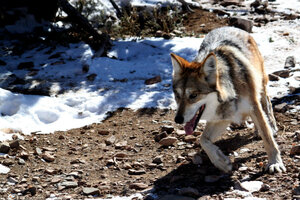Mexican gray wolf's reintroduction shows shifting views on conservation
The Mexican gray wolf almost disappeared in the 1970s. But four decades later, its reintroduction to the wild still spawns controversy and sheds light on mankind's changing perspectives on policy.

In this 2011 file photo, a female Mexican gray wolf looks to avoid being captured for its annual vaccinations and medical checkup at the Sevilleta National Wildlife Refuge in central New Mexico.
Susan Montoya Bryan/AP/File
It has been four decades since the Mexican gray wolf nearly fell to extinction.
Ostracized as vermin and portrayed as man-killers, they once numbered in the thousands before almost disappearing.
Yet, despite a 1998 federal plan for reintroduction to Arizona and New Mexico, the largest gray wolf species remains one of the most endangered animals in the world.
The reintroduction plan for the Mexican gray wolf called for bolstering the number living in the wild to 100 by 2006. The program has had some success, even as it has fallen considerably short of those initial projections.
The latest government statistics show roughly 110 wolves are now living in the wild. Among those, eight breeding pairs can be found in Gila and Apache national forests spanning the two Southwest states.
After decades of depleted numbers, many wolf species are making a slow comeback despite some opposition to their reintroduction.
The controversial topic represents a shift in the perception that wolves represent a danger to mankind. More recent disapproval seems to stem from fears over the killing of livestock, leaving a tangle of state and federal policies.
Many Americans now believe wolves are an important part of the North American ecosystem and as a society there is an ethical imperative to protect them. Polling has shown surging approval for the preservation of wolves.
Seventy percent of Americans believe wolves are an integral “part of American wilderness and natural heritage,” according to a national survey conducted in 2013 by Public Policy Polling. More than 50 percent of those polled said they would like to see a wolf in the wild.
Yet as national discussions turns from elimination to preservation, the reality on the ground in many states is more complicated, as the tug of differing opinions continues to play out between government, ranchers, conservation groups, and concerned citizens.
Political discourse can also influence policies linked to wolves. A program launched in 1995 to bring wolves back to the wild in Yellowstone National Park has often been held up as a benchmark for reintroduction, notwithstanding 2012 Congressional efforts to delist them as an endangered species.
As of 2014, 104 wolves were living in 11 packs in Yellowstone, while the number of livestock killed by wolves fell well below US National Park Service estimates.
While many ranchers continue to fervently object to programs favoring reintroduction of wolves to the wild because of concerns over the loss of livestock, some have taken a more holistic approach.
A group called the Range Riders now guard a bucolic valley in central Washington State, where wolves were introduced in 2011, using a combination of technology and horseback patrols meant to keep livestock safe.
“I’m not excited about it,” said local rancher Sam Kayser to Capital Press, a weekly publication. “But it doesn’t matter if I’m excited. We’re stuck with them. I want to think there’s room for all of us."
But even with the backing of the federal government, reintroducing wolves doesn’t always have an easy solution. A permit request by the US Fish and Wildlife Service to reintroduce the Mexican gray wolf into parts New Mexico this year was denied by the state-controlled New Mexico Department of Fish and Game, the Albuquerque Journal reported.
The FWS announced in mid-October it would use its federal authority to subvert opposition and push to install the wolf recovery program, according to the Journal.
Yet reintroducing wolves and other species remain essential to their recoveries, according to New Mexico’s Center of Biological Diversity, an advocacy group pushing for an increase in state’s biodiversity.
“Releasing Mexican wolves to the wild is the only way to save these animals from extinction,” said one of the group’s advocates, Michael Robinson, to the Journal. “It’s vital now that enough wolves get released to diversify their gene pool and ensure they don’t waste away from inbreeding.”


